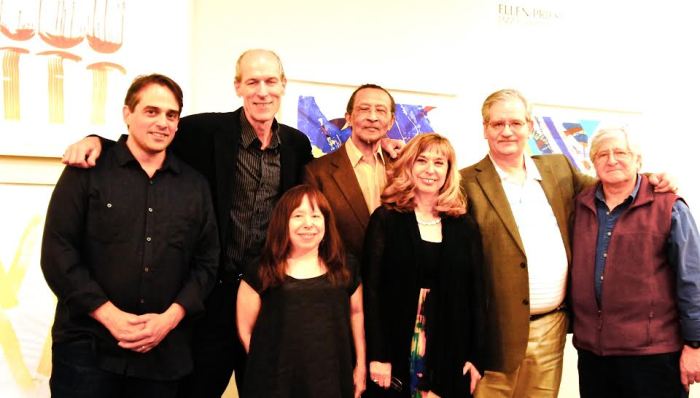
A CONCERT OF NEW MUSIC FOR WINDS AND PIANO ~ A REVIEW
Saturday, April 25, 2015 12:00 AM
The composers of New York Composers Circle April 21, 2015 New Music for Winds and Piano,
l-r: Max Giteck Duykers, David Picton, Peri Mauer, Gayther Myers, Susan J. Fischer, Richard Brooks, Eugene Marlow.
Concert of New Music for Winds and Piano
NYCC Concert
St. Peter’s Church, NYC
April 21, 2015
Written by Dave Hall
On Tuesday, April 21, 2015, I was pleased to attend a New York Composers Circle concert at St. Peter’s Church in New York City. Like previous NYCC concerts I’ve attended, this evening’s program, one dedicated to music for wind instruments, was varied and entertaining.
The evening began with a very beautiful piece for oboe, violin, cello and piano by Susan J. Fischer called “Intermezzo”. The next piece on the program was a work for solo oboe by Peri Mauer aptly called “Journey”. A fanciful piece that explored the full range and colors of the instrument, it was a beautifully vivid journey through sound and time. Next on the program was a work for flute, oboe, clarinet, horn and piano by Gayther Myers entitled “The Workday”. The composer, in his introduction to the piece, asked the audience to recall their average work day, with it’s ebb and flow of busy-ness, frustration, moments of calm, and finally, the end of the shift. The piece captured this very well and the interplay between the instruments was finely written and beautifully executed by the players. Following Mr. Myers piece was a work by Max Giteck Duykers called “Dark Body”. Scored for flute, violin, cello and piano, Duykers piece explored tone and rhythm in a series of short, exciting sections. It, too, was a very satisfying composition.
The second half of the program began with a four-movement work for oboe and guitar by David Picton. Called Turning Leaves for Sandy, this pastoral work with sections evoking first spring buds, summer passion, and fall colors traced the life of a year in a warm and elegant play between the oboe and guitar. Mr. Picton, a jazz player as well as a classical composer, injected an easy, melodic element into the evening’s program. The next piece in the concert, by Orlando Legname, was a two-part work for flute, clarinet, violin, cello and piano, with conductor. Called Vortici D’etere, it was an interesting late acoustic work by the recently deceased Signor Legname, who was as well known for his compositions for electronic instruments as for those he’d written for traditional concert instruments. Following Mr. Legname’s piece was a delightful three-part work for flute and alto flute by Eugene Marlow. Called Trois Chansons pour une Poetesse, it was originally written as a work for solo flute, but some years after composing it Mr. Marlow decided it would work nicely as a duet. He was right; it was quite lovely. One hopes that the poetess he had in mind would have been pleased with the songs. The final work in the program was Richard Brooks’ “Into the Twilight”. Scored for flute, bassoon, violin, viola and piano, the piece is built on a simple melody stated in the bassoon followed variations expanding on the melody’s intervals. It was a straightforward yet very enjoyable piece.
